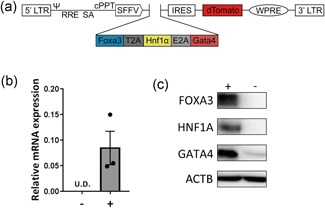Figure 1.

Design and efficacy of the polycistronic lentiviral vector. (a) Modular configuration of the self‐inactivating (SIN) vector backbones for expression of the hepatocyte transcription factors Foxa3, Hnf1α, and Gata4. (b) Relative mRNA expression of the exogenous genes in MEFs without transduction (–) and with transduction of FHG lentivirus after 5 days (+). Data are shown as mean ± SEM of three independent experiments for each group. (c) Protein expression of FOXA3, HNF1A, GATA4, and ACTB in untransduced (–) and transduced (+) MEFs. ψ: packaging signal; cPPT: central polypurine tract; FHG: Foxa3, Hnf1α and Gata4; Foxa3: Forkhead Box A3; Gata4: GATA Binding Protein 4; Hnf1α: HNF1 Homeobox A; IRES: internal ribosomal entry site; MEF: mouse embryonic fibroblasts; LTR: long terminal repeat; RRE: rev‐responsive element; SA: splice acceptor; SEM: standard error of the mean; SFFV: spleen focus‐forming virus U3 promoter; UD: undetectable; WPRE: woodchuck hepatitis virus [Color figure can be viewed at wileyonlinelibrary.com]
